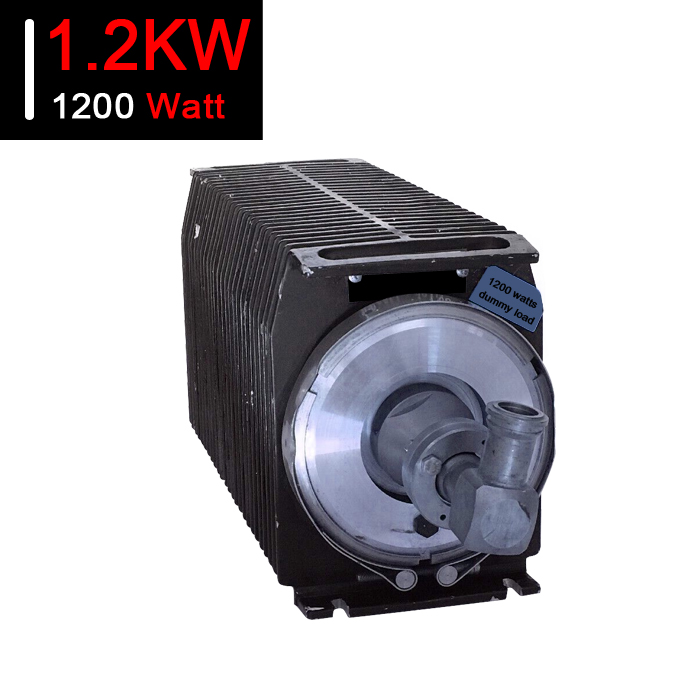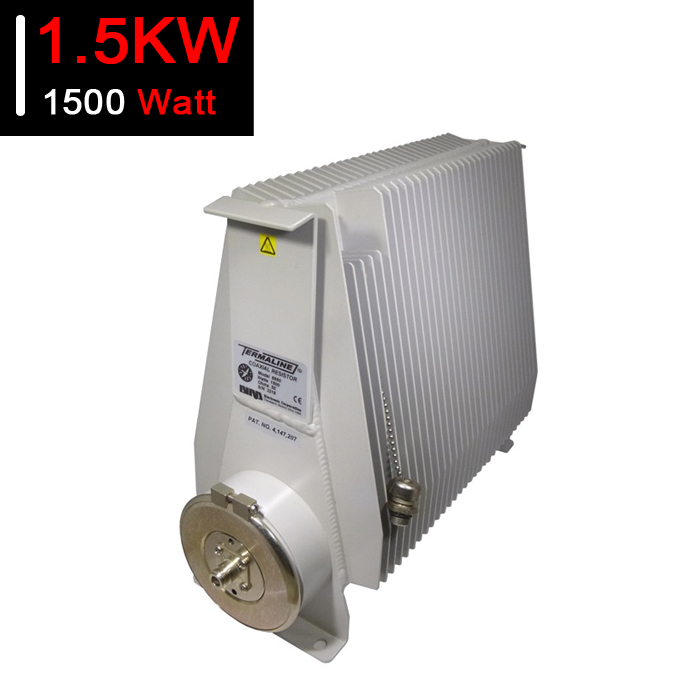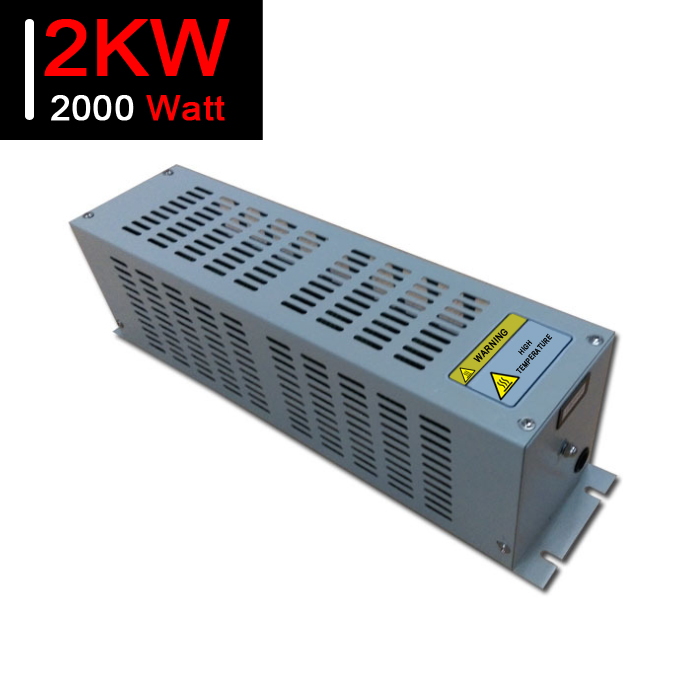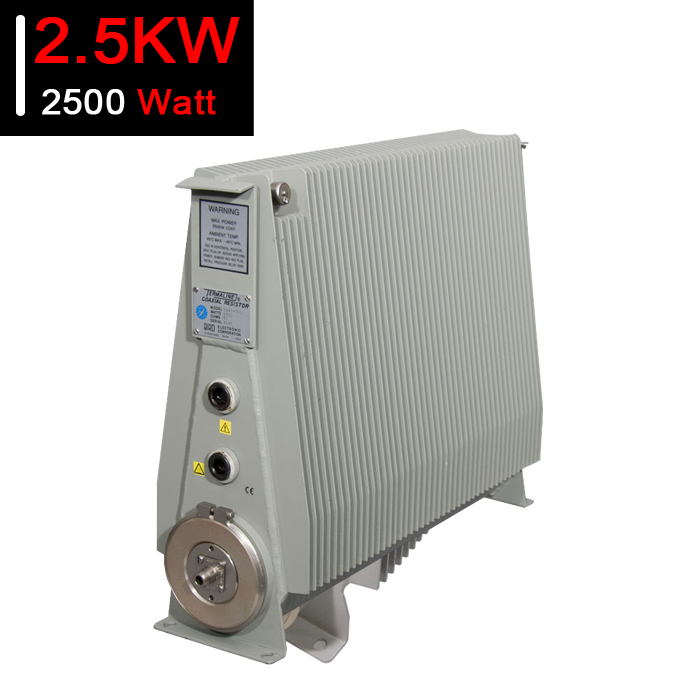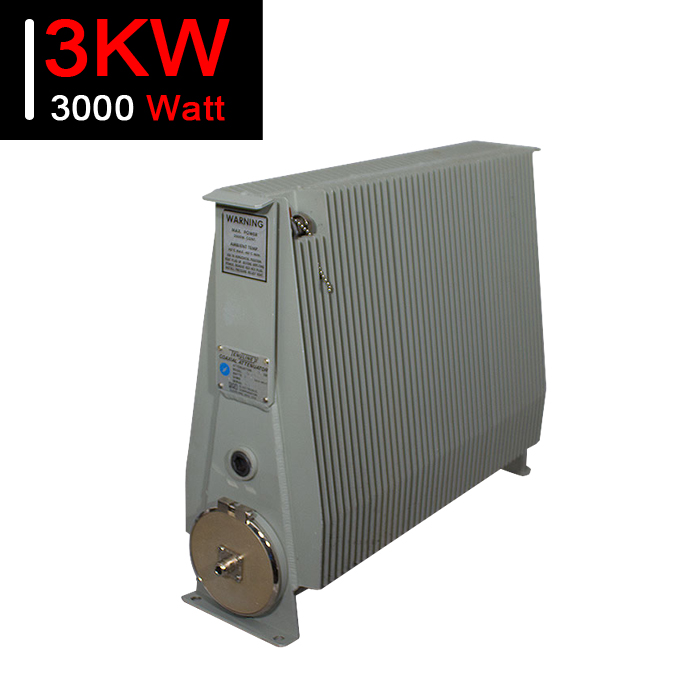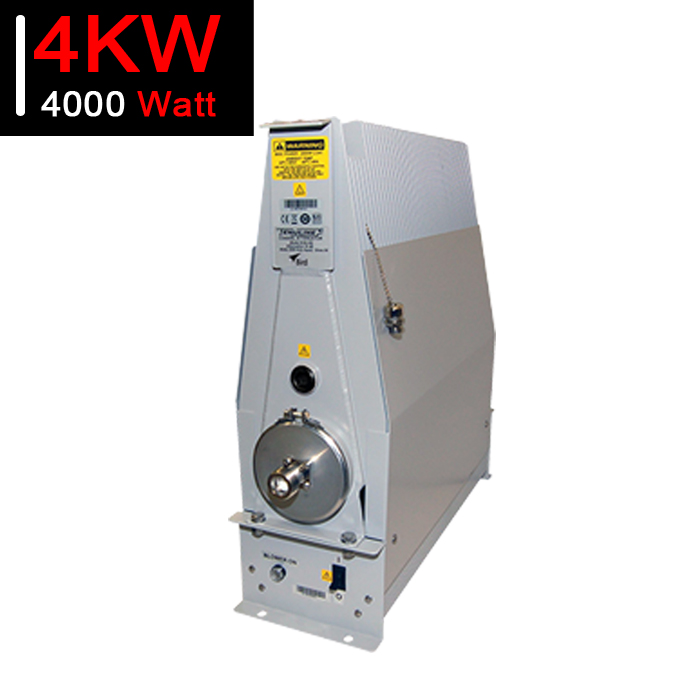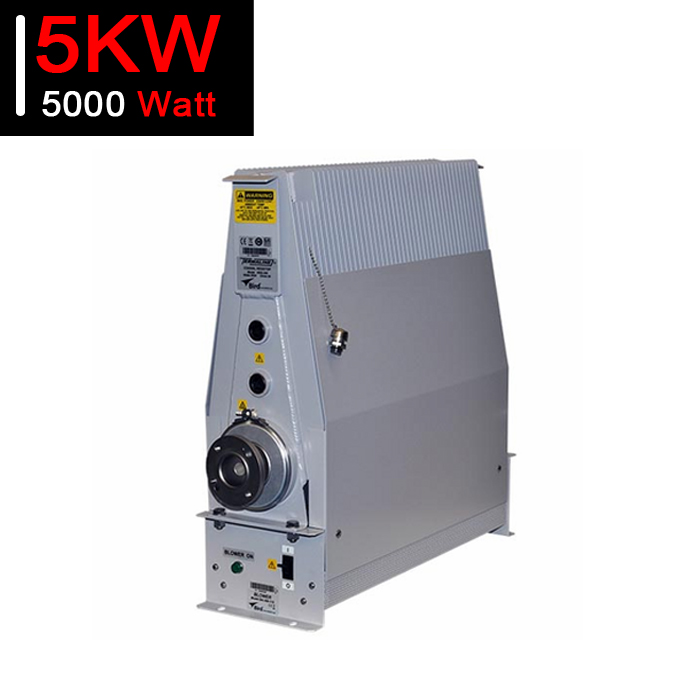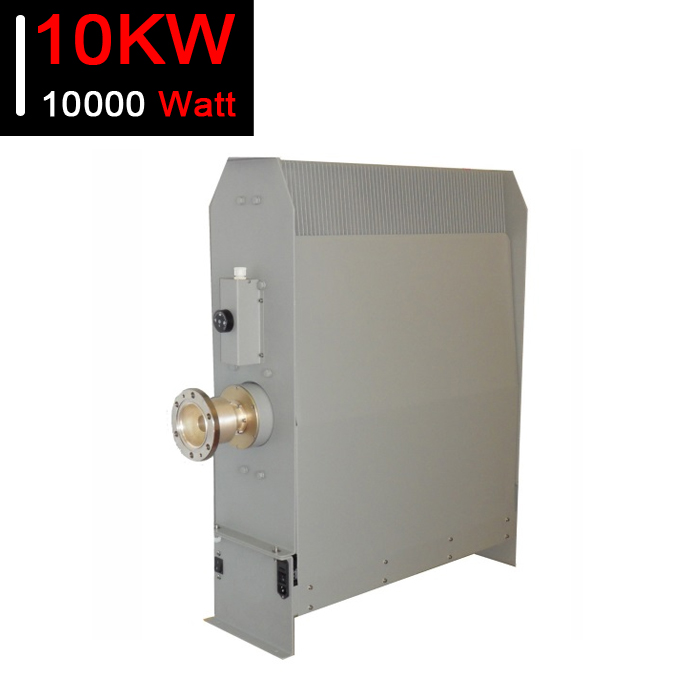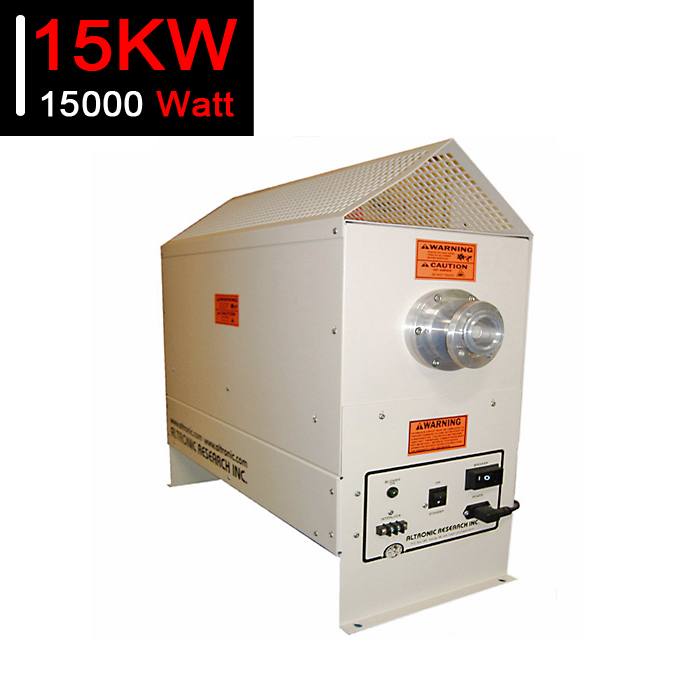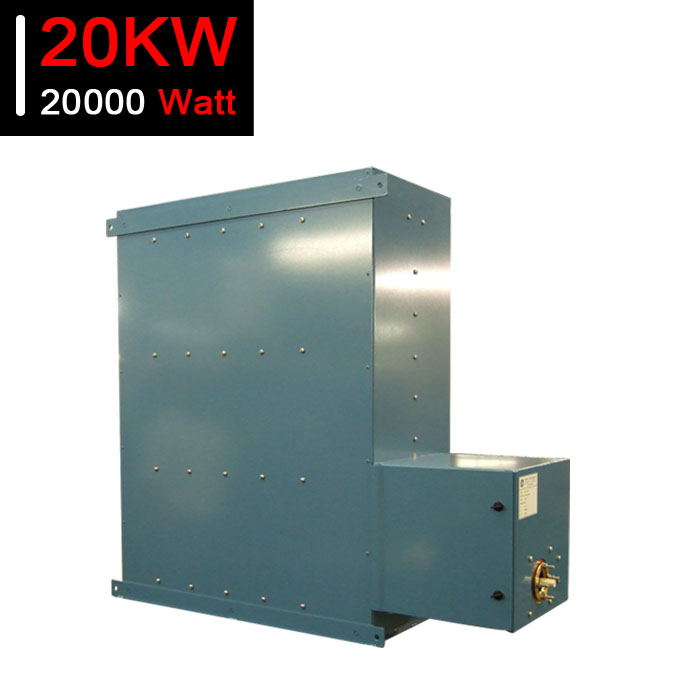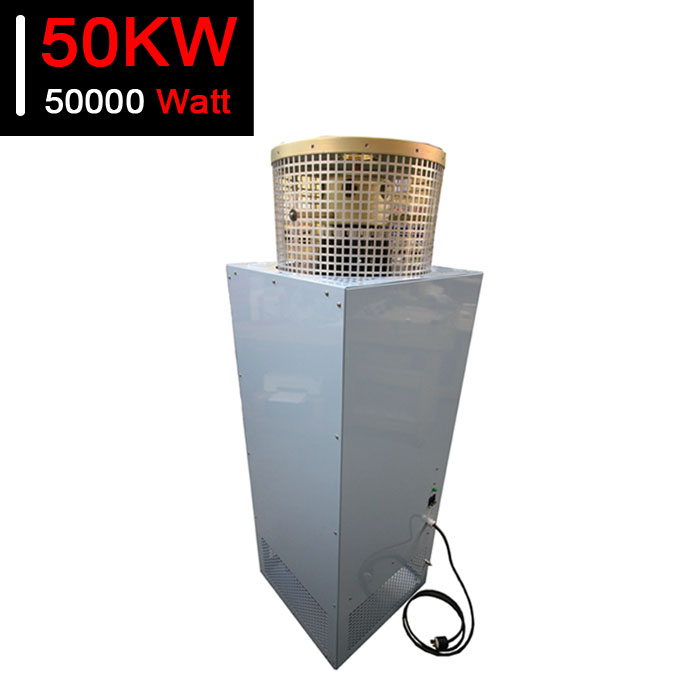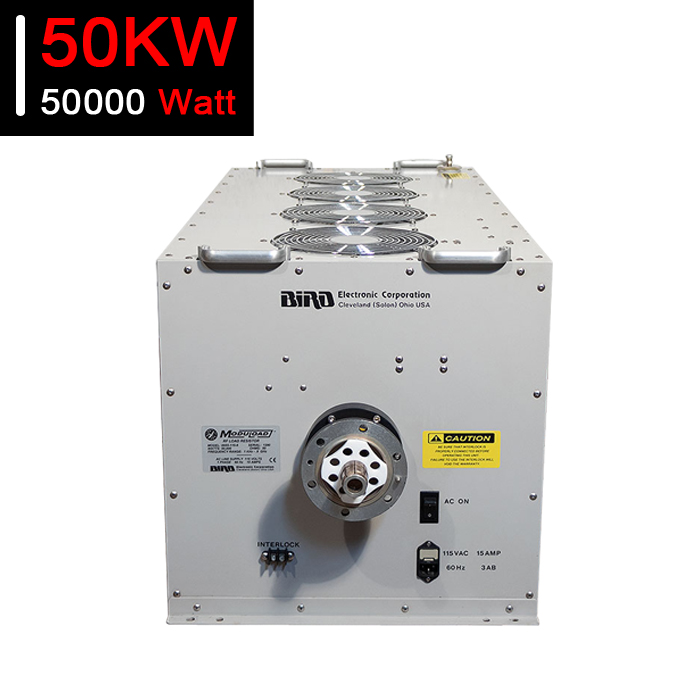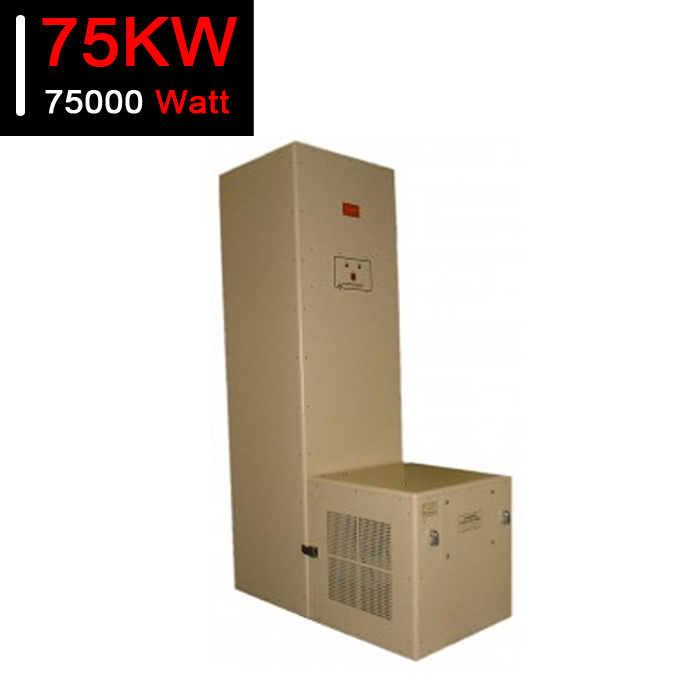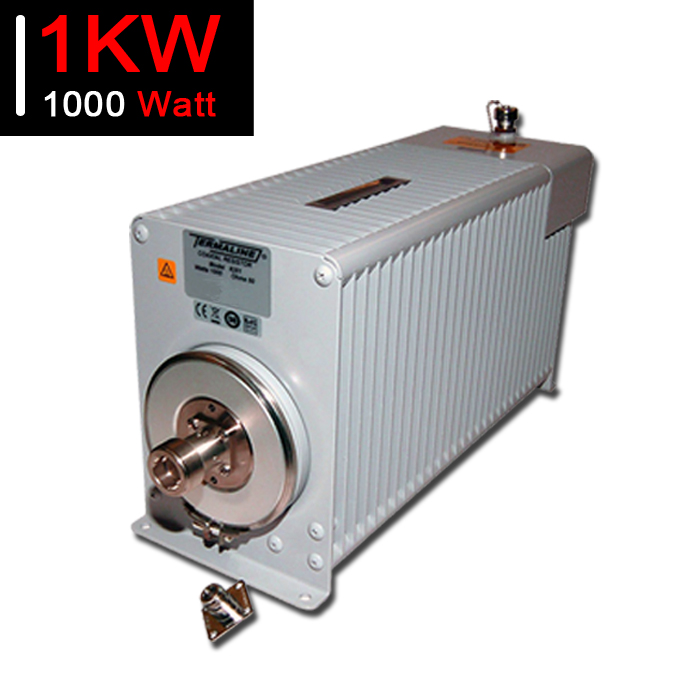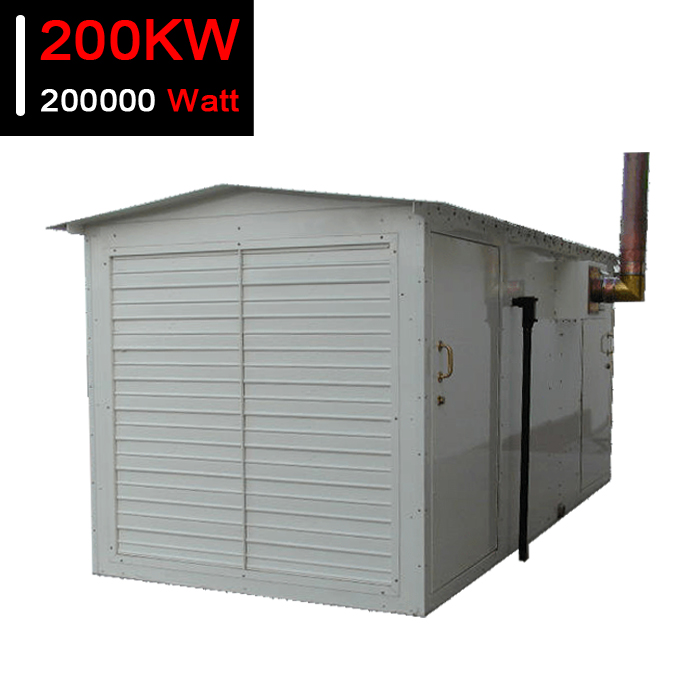
Tagħbijiet Dummy RF
Tagħbija finta RF hija apparat elettroniku li huwa ddisinjat biex jassorbi l-enerġija tal-frekwenza tar-radju (RF) u jikkonvertiha fis-sħana. Jintuża biex jissimula tagħbija fuq trasmettitur jew ċirkwit RF meta tittestja jew tirfina s-sistema, mingħajr ma fil-fatt tittrasmetti xi sinjali RF fl-ambjent.
It-tagħbija finta RF tikkonsisti f'element reżistenti li huwa ddisinjat biex jaqbel mal-impedenza tas-sistema RF li tkun qed tiġi ttestjata. L-element resistiv huwa tipikament magħmul minn wajer mhux induttiv mdawwar f'kolja jew materjal taċ-ċeramika b'reżistenza għolja. It-tagħbija mbagħad tiġi magħluqa f'sink tas-sħana biex tinħela l-enerġija li tiġi ġġenerata meta l-enerġija RF tiġi assorbita.
Xi sinonimi għal tagħbija finta RF jinkludu:
- Tagħbija RF
- Tagħbija finta
- Tagħbija ta 'impedenza
- Terminazzjoni RF
- Resistor tat-tagħbija
- Terminatur koassjali
- Tagħbija tat-test RF
- Terminatur tal-frekwenza tar-radju
- Assorbitur RF
- Attenwatur tas-sinjal
It-tagħbijiet finti RF huma għodda essenzjali fl-industrija tax-xandir għaliex jippermettu lix-xandara jittestjaw u jirranġaw it-tagħmir tagħhom mingħajr ma jarmu sinjali RF mhux mixtieqa. Meta t-tagħmir li jittrasmetti jiġi ttestjat, huwa importanti li jiġi żgurat li s-sinjal trażmess jiġi trażmess biss lir-riċevituri maħsuba u mhux barra fl-ambjent fejn jista 'jikkawża interferenza ma' sinjali tar-radju oħra.
Meta trasmettitur jew ċirkwit RF jiġi ttestjat b'tagħbija finta RF, it-tagħbija tissimula l-impedenza li tkun ippreżentata minn antenna jew komponenti RF oħra konnessi mas-sistema. Billi tagħmel hekk, is-sistema tista 'tiġi ttestjata u aġġustata mingħajr ma attwalment tirradja l-ebda enerġija. Dan huwa speċjalment importanti meta taħdem ma 'sistemi ta' enerġija għolja, fejn anke ammont żgħir ta 'emissjonijiet ta' enerġija jistgħu jkunu perikolużi.
Fix-xandir, tagħbijiet finta RF ta 'kwalità għolja huma partikolarment importanti minħabba li s-sinjali tax-xandir huma trażmessi f'livelli ta' qawwa għolja. Tagħbija finta RF ta 'kwalità għolja tista' tassorbi b'mod aktar effettiv l-enerġija ġġenerata minn sinjali RF ta 'qawwa għolja, li tgħin biex tevita li s-sistema tissaħħan iżżejjed jew tagħmel ħsara lill-komponenti.
L-użu ta 'tagħbija finta RF ta' kwalità baxxa jista 'jikkawża riflessjonijiet tas-sinjal, li jirriżulta f'sinjal instabbli jew imfixkel. Dan jista 'jwassal għal data mitlufa, sinjali waqgħu, jew kwistjonijiet oħra. Fi stazzjon tax-xandir professjonali, iż-żamma tal-integrità tas-sinjal hija kruċjali biex jiġi żgurat li x-xandira tiġi riċevuta u mifhuma mill-udjenza maħsuba.
B'mod ġenerali, it-tagħbijiet finta RF huma komponent importanti għall-ittestjar u l-kalibrazzjoni RF, li jipprovdu mod sikur u effiċjenti biex tissimula tagħbija RF fuq trasmettitur jew ċirkwit, tagħbija finta RF ta 'kwalità għolja hija importanti għal stazzjonijiet tax-xandir professjonali minħabba li tgħin biex tiżgura l- trażmissjoni preċiża ta 'sinjali RF u tipproteġi t-tagħmir mill-ħsara.
-
![1.2KW RF Dummy Load RF Load 1.2KW RF Termination 1200 Watt Attenuator for Sale]()
1.2KW RF Dummy Tagħbija RF Tagħbija 1.2KW RF Terminazzjoni 1200 Watt Attenwatur għall-Bejgħ
Prezz (USD): Itlob għal kwotazzjoni
Mibjugħa: 18
-
![1.5KW RF Dummy Load RF Load 1.5KW RF Termination 1500 Watt Attenuator for Sale]()
1.5KW RF Dummy Tagħbija RF Tagħbija 1.5KW RF Terminazzjoni 1500 Watt Attenwatur għall-Bejgħ
Prezz (USD): Itlob għal kwotazzjoni
Mibjugħa: 41
-
![2KW RF Dummy Load RF Load 2KW RF Termination 2000 Watt Attenuator for Sale]()
2KW RF Dummy Tagħbija RF Tagħbija 2KW RF Terminazzjoni 2000 Watt Attenwatur għall-Bejgħ
Prezz (USD): Itlob għal kwotazzjoni
Mibjugħa: 31
-
![2.5KW RF Dummy Load RF Load 2.5KW RF Termination 2500 Watt Attenuator for Sale]()
2.5KW RF Dummy Tagħbija RF Tagħbija 2.5KW RF Terminazzjoni 2500 Watt Attenwatur għall-Bejgħ
Prezz (USD): Itlob għal kwotazzjoni
Mibjugħa: 25
-
![3KW RF Dummy Load RF Load 3KW RF Termination 1000 Watt Attenuator for Sale]()
3KW RF Dummy Tagħbija RF Tagħbija 3KW RF Terminazzjoni 1000 Watt Attenwatur għall-Bejgħ
Prezz (USD): Itlob għal kwotazzjoni
Mibjugħa: 15
-
![4KW RF Dummy Load RF Load 4KW RF Termination 4000 Watt Attenuator for Sale]()
4KW RF Dummy Tagħbija RF Tagħbija 4KW RF Terminazzjoni 4000 Watt Attenwatur għall-Bejgħ
Prezz (USD): Itlob għal kwotazzjoni
Mibjugħa: 17
-
![5KW RF Dummy Load RF Load 5KW RF Termination 5000 Watt Attenuator for Sale]()
5KW RF Dummy Tagħbija RF Tagħbija 5KW RF Terminazzjoni 5000 Watt Attenwatur għall-Bejgħ
Prezz (USD): Itlob għal kwotazzjoni
Mibjugħa: 17
-
![10KW RF Dummy Load RF Load 10KW RF Termination 10000 Watt Attenuator for Sale]()
10KW RF Dummy Tagħbija RF Tagħbija 10KW RF Terminazzjoni 10000 Watt Attenwatur għall-Bejgħ
Prezz (USD): Itlob għal kwotazzjoni
Mibjugħa: 17
-
![15KW RF Dummy Load RF Load 15KW RF Termination 10000 Watt Attenuator for Sale]()
15KW RF Dummy Tagħbija RF Tagħbija 15KW RF Terminazzjoni 10000 Watt Attenwatur għall-Bejgħ
Prezz (USD): Itlob għal kwotazzjoni
Mibjugħa: 13
-
![20KW RF Dummy Load RF Load 20KW RF Termination 20000 Watt Attenuator for Sale]()
20KW RF Dummy Tagħbija RF Tagħbija 20KW RF Terminazzjoni 20000 Watt Attenwatur għall-Bejgħ
Prezz (USD): Itlob għal kwotazzjoni
Mibjugħa: 14
-
![50KW RF Dummy Load RF Load 50KW RF Termination 50000 Watt Attenuator for Sale]()
50KW RF Dummy Tagħbija RF Tagħbija 50KW RF Terminazzjoni 50000 Watt Attenwatur għall-Bejgħ
Prezz (USD): Itlob għal kwotazzjoni
Mibjugħa: 9
-
![50KW RF Dummy Load RF Load 50KW RF Termination 50000 Watt Attenuator for Sale]()
50KW RF Dummy Tagħbija RF Tagħbija 50KW RF Terminazzjoni 50000 Watt Attenwatur għall-Bejgħ
Prezz (USD): Itlob għal kwotazzjoni
Mibjugħa: 35
-
![75KW RF Dummy Load RF Load 50KW RF Termination 75000 Watt Attenuator for Sale]()
75KW RF Dummy Tagħbija RF Tagħbija 50KW RF Terminazzjoni 75000 Watt Attenwatur għall-Bejgħ
Prezz (USD): Itlob għal kwotazzjoni
Mibjugħa: 4
-
![100KW RF Dummy Load RF Load 100KW RF Termination 100000 Watt Attenuator for Sale]()
100KW RF Dummy Tagħbija RF Tagħbija 100KW RF Terminazzjoni 100000 Watt Attenwatur għall-Bejgħ
Prezz (USD): Itlob għal kwotazzjoni
Mibjugħa: 3
-
![1KW RF Dummy Load RF Load 1KW RF Termination 1000 Watt Attenuator for Sale]()
1KW RF Dummy Tagħbija RF Tagħbija 1KW RF Terminazzjoni 1000 Watt Attenwatur għall-Bejgħ
Prezz (USD): Itlob għal kwotazzjoni
Mibjugħa: 54
-
![200KW RF Dummy Load RF Load 200KW RF Termination 100000 Watt Attenuator for Sale]()
200KW RF Dummy Tagħbija RF Tagħbija 200KW RF Terminazzjoni 100000 Watt Attenwatur għall-Bejgħ
Prezz (USD): Jekk jogħġbok Ikkuntattjana
Mibjugħa: 2
- X'iktar tagħmir jintuża flimkien ma 'tagħbija finta RF meta xandir?
- Waqt ix-xandir, hemm numru ta 'biċċiet ta' tagħmir li jintużaw flimkien ma 'tagħbija finta RF. Hawn huma xi wħud mill-aktar komponenti komuni:
1. Trasmettitur: It-trasmettitur huwa l-qalba tas-sistema tax-xandir. Jiġġenera s-sinjal tal-frekwenza tar-radju li jiġi trażmess fuq l-airwaves, u huwa konness mat-tagħbija finta RF waqt l-ittestjar u l-irfinar.
2. Antenna: L-antenna hija l-komponent li jirradja s-sinjal RF fl-ambjent. Huwa konness mat-trasmettitur u huwa pożizzjonat biex jippropaga l-aħjar is-sinjal lis-semmiegħa maħsuba.
3. Filtru RF: Filtri RF jintużaw biex inaddfu s-sinjal qabel ma jintbagħat lill-antenna, u jneħħu kwalunkwe frekwenzi jew interferenza mhux mixtieqa li setgħu ġew introdotti matul il-proċess ta 'modulazzjoni.
4. amplifikatur RF: L-amplifikaturi RF jintużaw biex jagħtu spinta lill-qawwa tas-sinjal RF. Fix-xandir, l-amplifikaturi RF ħafna drabi jintużaw biex iżidu s-saħħa tas-sinjal sabiex tkun tista 'tilħaq udjenza usa'.
5. Modulatur: Il-modulatur huwa responsabbli għall-kodifikazzjoni tas-sinjal tal-awdjo fuq is-sinjal tal-ġarr tal-frekwenza tar-radju. Jintuża biex ivarja l-amplitudni, il-frekwenza, jew il-fażi tas-sinjal tal-ġarr bi tweġiba għas-sinjal tal-awdjo.
6. Tagħmir għall-ipproċessar tal-awdjo: It-tagħmir tal-ipproċessar tal-awdjo jintuża biex itejjeb iċ-ċarezza, il-qawwa u kwalitajiet oħra tas-sinjal tal-awdjo qabel ma jiġi modulat fuq is-sinjal tal-ġarr RF.
7. Provvista ta 'enerġija: Il-provvista tal-enerġija tipprovdi l-enerġija elettrika meħtieġa biex tħaddem it-tagħmir tax-xandir.
Dawn il-biċċiet ta 'tagħmir kollha jaħdmu flimkien biex joħolqu sinjal ta' xandir ċar u ta 'kwalità għolja li jista' jilħaq udjenza wiesgħa. It-tagħbija finta RF hija komponent kritiku f'dan il-proċess, peress li tippermetti ttestjar u rfinar sikur u preċiż tat-tagħmir tax-xandir mingħajr ma jittrażmetti sinjali RF mhux mixtieqa fl-ambjent.
- X'inhuma tipi komuni ta 'tagħbija finta RF użati għax-xandir bir-radju?
- Hemm diversi tipi ta 'tagħbijiet finta RF disponibbli, kull wieħed bid-disinn u l-iskop uniku tiegħu stess. Hawnhekk hawn ħarsa ġenerali lejn uħud mit-tipi l-aktar komuni:
1. Tagħbija finta bil-wajer: Dan it-tip ta 'tagħbija finta huwa magħmul minn wajer ta' preċiżjoni mdawwar f'kolja, u huwa tipikament użat għal applikazzjonijiet ta 'enerġija baxxa. Joffri tkessiħ tajjeb minħabba l-istruttura miftuħa tiegħu, iżda jista 'jbati minn problemi bl-inductance u l-kapaċità fi frekwenzi ogħla.
2. Tagħbija finta kompost tal-karbonju: Dan it-tip ta 'tagħbija finta hija magħmula minn materjal kompost li fih karbonju u materjali oħra. Joffri dissipazzjoni tajba tas-sħana u kapaċità ta 'ġestjoni tal-enerġija, iżda jista' jkun aktar għali minn tipi oħra.
3. Tagħbija finta mkessħa bl-arja: Dan huwa tip ta 'tagħbija finta sempliċi u bi prezz baxx li juża l-fluss ta' l-arja biex ikessaħ l-element reżistenti. Tipikament jintuża għal applikazzjonijiet ta 'enerġija baxxa, u jista' jkun storbjuż u suxxettibbli għal sħana żejda.
4. Tagħbija finta mkessħa biż-żejt: Dan it-tip ta 'tagħbija finta juża żejt biex ikessaħ l-element reżistenti, li joffri dissipazzjoni tas-sħana aħjar minn mudelli mkessħa bl-arja. Tipikament jintuża għal applikazzjonijiet ta 'qawwa ogħla iżda jista' jkun diffiċli biex jinżamm u jissewwa.
5. Waveguide Dummy Tagħbija: It-tagħbijiet finta tal-gwida tal-mewġ huma ddisinjati biex itemmu l-istrutturi tal-gwida tal-mewġ u huma tipikament użati f'applikazzjonijiet microwave ta 'qawwa għolja. Huma apparati speċjalizzati li huma ddisinjati għal firxa ta 'frekwenza speċifika, u jistgħu jkunu għaljin.
6. Tagħbija finta mkessħa bil-fann: It-tagħbijiet finta mkessħa bil-fann jużaw fann biex ikessħu l-element resistiv, li joffru tkessiħ tajjeb u kapaċità ta 'ġestjoni tal-enerġija. Dawn huma tipikament użati għal applikazzjonijiet ta 'enerġija medja u jistgħu jkunu aktar għaljin minn mudelli mkessħa bl-arja.
Fil-qosor, it-tip ta 'tagħbija finta RF użata jiddependi fuq ir-rekwiżiti tal-applikazzjoni, bħall-kapaċità tal-immaniġġjar tal-enerġija, il-firxa tal-frekwenza, il-metodu tat-tkessiħ u l-ispiża. It-tagħbijiet finta bil-wajer huma tipikament użati għal applikazzjonijiet ta 'enerġija baxxa, filwaqt li mudelli mkessħa biż-żejt u mkessħa bil-fann huma aħjar għal applikazzjonijiet ta' qawwa medja għal għolja. It-tagħbijiet finta Waveguide huma apparati speċjalizzati użati għal firxiet ta 'frekwenza speċifiċi, filwaqt li mudelli mkessħa bl-arja huma għażliet sempliċi u bi prezz baxx għal applikazzjonijiet ta' enerġija baxxa. L-ispiża ta 'dawn it-tagħbijiet finta RF tvarja skond it-tip, b'mudelli aktar speċjalizzati jew ta' prestazzjoni għolja jkunu aktar għaljin. L-installazzjoni ta 'dawn l-apparati tipikament tinvolvi l-konnessjoni tagħhom mat-tagħmir xieraq, filwaqt li l-manutenzjoni u t-tiswija jistgħu jinkludu sostituzzjoni ta' elementi reżistenti jew sistemi ta 'tkessiħ bil-ħsara.
- X'inhu differenti tagħbija finta RF żgħira u kbira?
- Id-differenzi ewlenin bejn tagħbija finta RF żgħira u tagħbija finta RF kbira huma fl-istrutturi tagħhom, il-metodi tat-tkessiħ, il-kapaċità tal-immaniġġjar tal-enerġija, u l-applikazzjonijiet. Hawn paragun aktar dettaljat:
Struttura:
Tagħbijiet żgħar finta RF tipikament għandhom daqs kompatt u huma ddisinjati biex jimmaniġġjaw livelli ta 'enerġija aktar baxxi. Jistgħu jkollhom struttura komposta bil-wajer jew tal-karbonju u jużaw tkessiħ bl-arja jew bil-likwidu. Tagħbijiet kbar RF finta, min-naħa l-oħra, huma ħafna akbar fid-daqs u kapaċi jimmaniġġjaw livelli ta 'enerġija ferm ogħla. Ħafna drabi jużaw żejt jew sistema mkessħa bl-ilma u għandhom struttura aktar robusta.
vantaġġi:
Tagħbijiet finta RF żgħar għandhom il-vantaġġ li jkunu kompatti u anqas għaljin minn tagħbijiet finta kbar. Huma wkoll aktar faċli biex jimmaniġġaw u jittrasportaw. Tagħbijiet kbar RF finta, min-naħa l-oħra, jistgħu jimmaniġġjaw livelli ta 'enerġija ferm ogħla u huma adattati għal applikazzjonijiet ta' qawwa għolja bħax-xandir jew l-ittestjar RF industrijali.
żvantaġġi:
L-iżvantaġġi ta 'tagħbijiet finta RF żgħar huma l-kapaċità limitata tagħhom għall-immaniġġjar tal-enerġija u tolleranza aktar baxxa għall-bidliet fil-frekwenza. Tagħbijiet manikini RF kbar huma ħafna aktar għaljin, kbar ħafna fid-daqs, u jeħtieġu aktar manutenzjoni.
Kapaċità tal-immaniġġjar tal-enerġija:
Tagħbijiet żgħar finta RF jistgħu jimmaniġġjaw biss ammont limitat ta 'enerġija, ġeneralment biss ftit watts jew milliwatts. Tagħbijiet finta RF kbar, min-naħa l-oħra, jistgħu jimmaniġġjaw livelli ta 'enerġija ferm ogħla, sa mijiet ta' kilowatts.
Metodu tkessiħ:
Il-metodu tat-tkessiħ għal tagħbijiet finti RF żgħar huwa tipikament ibbażat fuq l-arja jew likwidu, filwaqt li tagħbijiet manikini RF kbar ħafna drabi jużaw żejt jew sistema mkessħa bl-ilma.
Prezzijiet:
It-tagħbijiet finti RF żgħar huma ġeneralment inqas għaljin minn tagħbijiet finti RF kbar, minħabba d-daqs iżgħar tagħhom u l-kapaċità tal-immaniġġjar tal-enerġija aktar baxxa.
Applikazzjonijiet:
Tagħbijiet finti RF żgħar ħafna drabi jintużaw għal applikazzjonijiet ta 'laboratorju u ttestjar, filwaqt li tagħbijiet finti RF kbar jintużaw fix-xandir, ittestjar industrijali, jew fejn huma meħtieġa tagħbijiet ta' qawwa għolja.
daqs:
Tagħbijiet żgħar finta RF huma ġeneralment kompatti fid-daqs, filwaqt li tagħbijiet finta RF kbar jistgħu jkunu kbar ħafna u jeħtieġu ammont sinifikanti ta 'spazju.
Prestazzjoni:
Tagħbijiet finti RF żgħar huma aktar suxxettibbli għal kwistjonijiet ta 'prestazzjoni kkawżati minn bidliet fil-frekwenza, filwaqt li tagħbijiet finti RF kbar huma ddisinjati għal operazzjonijiet heavy-duty u huma ħafna aktar affidabbli.
Frekwenza:
Tagħbijiet finti RF żgħar huma ġeneralment limitati għal firxiet ta 'frekwenzi speċifiċi, filwaqt li tagħbijiet finti RF kbar jistgħu jimmaniġġjaw firxa wiesgħa ta' frekwenzi.
Installazzjoni u manutenzjoni:
L-installazzjoni ta 'tagħbijiet żgħar finta RF hija ġeneralment sempliċi u sempliċi. Madankollu, tagħbijiet finta RF kbar jeħtieġu installazzjoni u manutenzjoni speċjalizzati minħabba l-istruttura u s-sistemi tat-tkessiħ aktar kumplessi tagħhom.
Fil-qosor, tagħbijiet finti RF żgħar huma tipikament użati għal applikazzjonijiet ta 'laboratorju u ttestjar minħabba d-daqs kompatt u l-affordabbiltà tagħhom, filwaqt li tagħbijiet manikini RF kbar jintużaw fix-xandir u l-ittestjar industrijali minħabba l-kapaċità ta' immaniġġjar ta 'qawwa għolja tagħhom u struttura aktar robusta. Tagħbijiet finti RF żgħar tipikament jużaw tkessiħ bl-arja jew likwidu, filwaqt li tagħbijiet finti RF kbar jużaw sistemi mkessħa bl-ilma jew taż-żejt.
- Kif jintużaw it-tagħbijiet finta RF fix-xeni attwali?
- It-tagħbijiet finta RF għandhom firxa wiesgħa ta 'applikazzjonijiet f'oqsma differenti tal-elettronika u l-komunikazzjonijiet. Hawn huma xi wħud mill-applikazzjonijiet komuni tat-tagħbijiet finta RF:
1. Ittestjar u kalibrazzjoni: Tagħbijiet finta RF ħafna drabi jintużaw fl-ittestjar u l-kalibrazzjoni ta 'tagħmir RF, bħal trasmettituri, amplifikaturi u riċevituri. Huma jipprovdu tagħbija mhux radjazzjoni li hija kruċjali għall-ittestjar tat-tagħmir mingħajr ma jinterferixxu ma 'apparati ta' komunikazzjoni oħra.
2. Netwerks li jaqblu: It-tagħbijiet finti RF jistgħu jintużaw bħala netwerks li jaqblu għall-ittestjar tal-istadji tal-amplifikatur tal-qawwa RF. Huma jipprovdu tagħbija resistiva li tista 'tqabbel l-impedenza tal-amplifikatur, li tagħmilha possibbli li tittestja l-prestazzjoni tiegħu b'mod preċiż.
3. Soluzzjoni ta 'problemi: Tagħbijiet finta RF jistgħu jintużaw ukoll fl-issolvi l-problemi u s-sejba ta 'ħsarat ta' tagħmir RF. Billi tissostitwixxi temporanjament l-antenna b'tagħbija finta, l-inġiniera jistgħu jivverifikaw jekk sseħħx ħsara fit-trasmettitur jew fit-tagħmir li jirċievi.
4. Stazzjonijiet tax-xandir: Fl-istazzjonijiet tax-xandir, it-tagħbijiet finti RF huma tipikament użati waqt l-ittestjar u l-manutenzjoni tat-tagħmir li jittrasmetti. Jgħinu biex jiżolaw il-ġeneratur u t-trasmettitur tal-istazzjon mill-antenna filwaqt li jżommu t-taqbila korretta tal-impedenza.
5. Ittestjar industrijali: Tagħbijiet finta RF jintużaw fl-ittestjar industrijali ta 'tagħmir ta' frekwenza tar-radju, bħal antenni tal-ittestjar, filtri u gwidi tal-mewġ.
6. Immaġini mediċi: Tagħbijiet finta RF jintużaw f'tagħmir ta 'l-immaġini mediċi, bħal skaners MRI, biex jassorbu l-qawwa RF li mhix assorbita mill-ġisem tal-bniedem. Dan jgħin biex jipprevjeni espożizzjoni għar-radjazzjoni mhux mixtieqa lill-pazjent u lill-ħaddiema tal-kura tas-saħħa.
7. Applikazzjonijiet militari: It-tagħbijiet finti RF jintużaw f'applikazzjonijiet militari, bħall-ittestjar ta 'sistemi ta' komunikazzjoni, radar, u tagħmir tal-gwerra elettronika. Jgħinu biex jiżguraw it-tħaddim tajjeb ta 'dawn is-sistemi filwaqt li jipprevjenu emissjonijiet RF mhux mixtieqa li jistgħu jikkompromettu l-pożizzjoni tal-militar.
8. Operaturi tar-radju tal-perżut: It-tagħbijiet finti RF huma komunement użati mill-operaturi tar-radju tal-perżut għall-ittestjar u l-aġġustament tat-tagħmir tar-radju tagħhom. Jistgħu jgħinu biex jiżguraw li r-radju qed jaħdem b'mod korrett qabel ma jagħmlu xi trażmissjonijiet.
9. Edukazzjoni u taħriġ: It-tagħbijiet finti RF huma utli f'settings edukattivi u ta 'taħriġ għat-tagħlim dwar it-tħaddim u l-manutenzjoni xierqa tat-tagħmir RF. Jistgħu jintużaw ukoll biex juru t-teorija RF u biex jitgħallmu dwar tekniki ta 'ttestjar u kalibrazzjoni.
10. Rocketry dilettanti: It-tagħbijiet finta RF xi kultant jintużaw fir-rokits tad-dilettanti biex jittestjaw l-art igniters u sistemi elettriċi qabel it-tnedija. Dan jista 'jgħin biex tiġi żgurata s-sikurezza u l-effettività tat-tnedija.
11. Ittestjar aerospazjali: Tagħbijiet finta RF jistgħu jintużaw fl-ittestjar aerospazjali biex jissimulaw l-impedenza ta 'antenni u tagħmir RF ieħor. Dan jgħin biex jiġi żgurat it-tħaddim tajjeb tat-tagħmir f'ambjenti differenti.
12. Riċerka u żvilupp: Tagħbijiet finta RF jintużaw fir-riċerka u l-iżvilupp biex tittestja l-prestazzjoni ta 'tagħmir u teknoloġiji RF ġodda. Jistgħu jgħinu biex jidentifikaw il-potenzjal għal interferenza RF, ineffiċjenza, jew kwistjonijiet oħra li jistgħu jinqalgħu.
Fil-qosor, it-tagħbijiet finta RF għandhom bosta applikazzjonijiet f'oqsma differenti tal-elettronika u l-komunikazzjonijiet. Huma komunement użati għall-ittestjar u l-kalibrazzjoni ta 'tagħmir RF, issolvi l-problemi, netwerks ta' tqabbil, stazzjonijiet tax-xandir, ittestjar industrijali, immaġini mediċi, u applikazzjonijiet militari, eċċ.
- Apparti tagħbija finta, x'apparat ieħor jintuża biex tinbena sistema ta' xandir?
- Il-bini ta 'sistema kompluta ta' braodcasting tar-radju għal stazzjon tax-xandir jeħtieġ aktar minn sempliċiment tagħbija finta RF. Hawn huma l-komponenti tipiċi meħtieġa għal sistema kompleta tax-xandir bir-radju:
1. Torri ta 'l-antenna: Jinħtieġ torri biex titwaħħal l-antenna f'elevazzjoni għolja biżżejjed biex tiżgura żona ta 'kopertura wiesgħa.
2. Antenna: L-antenna hija responsabbli biex tirradja s-sinjal tax-xandir fiż-żona tal-madwar. Jintużaw tipi differenti ta 'antenni skont il-medda ta' frekwenza u t-tip ta 'xandir.
3. Linja ta 'trażmissjoni: Linja ta 'trażmissjoni tintuża biex tgħaqqad it-trasmettitur ma' l-antenna. Il-linja tat-trasmissjoni jeħtieġ li tintgħażel bir-reqqa biex timminimizza t-telf fuq id-distanza meħtieġa.
4. Trasmettitur: It-trasmettitur jiġġenera s-sinjal RF li jintbagħat lill-antenna. It-trasmettitur jeħtieġ li jitħaddem fi ħdan l-ispeċifikazzjonijiet tal-antenna u l-linja ta 'trażmissjoni biex tiġi evitata l-ħsara.
5. tuner ta ' l-antenna: Jista 'jkun meħtieġ tuner tal-antenna biex tqabbel l-impedenza tat-trasmettitur mal-impedenza tal-antenna għall-aħjar prestazzjoni.
6. Protezzjoni mis-sajjetti: Is-sajjetti jistgħu jikkawżaw ħsara lill-linja tat-trażmissjoni, it-torri, u komponenti oħra tas-sistema tal-antenna. Is-soppressori tas-surge u apparat ieħor għall-protezzjoni tas-sajjetti huma tipikament użati biex jipprevjenu l-ħsara.
7. Sistema ta' ertjar: Sistema ta 'l-ert hija meħtieġa biex tipproteġi kontra sajjetti, skarigu statiku, u avvenimenti elettriċi oħra. Is-sistema tal-ert għandha tkun iddisinjata u installata biex timminimizza l-interferenza mat-tħaddim tas-sistema tal-antenna.
8. Sistema ta 'kontroll u monitoraġġ mill-bogħod: Sistema ta 'kontroll u monitoraġġ mill-bogħod tintuża biex timmonitorja u tikkontrolla mill-bogħod il-prestazzjoni tas-sistema tal-antenna, inkluża l-qawwa tat-trasmettitur, il-kwalità tal-awdjo, u parametri importanti oħra.
9. Provvista ta 'enerġija: Provvista ta 'enerġija hija meħtieġa biex tipprovdi enerġija elettrika lit-trasmettitur, sistema ta' kontroll mill-bogħod, u komponenti oħra tas-sistema ta 'l-antenna.
10. Audio console/mixer: Il-console/mixer tal-awdjo jintuża biex iħallat u jikkontrolla l-livelli tal-awdjo għall-ipprogrammar li se jixxandar fuq l-istazzjon. L-awdjo jista 'jiddaħħal fil-mixer minn sorsi varji, bħal mikrofoni, kontenut irreġistrat minn qabel, linji tat-telefon, u għalf barra mis-sit.
11. Mikrofoni: Mikrofoni ta’ kwalità tax-xandir jintużaw biex jinqabdu diskors u kontenut awdjo ieħor li se jixxandar fuq l-istazzjon tar-radju.
12. Istazzjon tax-xogħol tal-awdjo diġitali (DAW)/softwer tal-editjar tal-awdjo: Is-softwer DAW jintuża biex jinħoloq u jeditja kontenut awdjo għax-xandir. Dan is-software jista' jintuża wkoll għall-arkivjar u l-ħażna tal-awdjo.
13. Interfaces tat-telefon: L-interfaces tat-telefon jintużaw biex jippermettu li t-talent fuq l-arja jieħu sejħiet deħlin mis-semmiegħa. Dawn l-interfaces jistgħu jintużaw biex jimmaniġġaw l-iskrinjar tas-sejħiet, iħalltu sejħiet deħlin mal-programm, u funzjonijiet oħra.
14. Proċessuri tal-awdjo: Il-proċessuri tal-awdjo jintużaw biex jottimizzaw il-kwalità tal-awdjo tas-sinjal tax-xandir. Jistgħu jintużaw biex jikkontrollaw il-livelli, l-ekwalizzazzjoni, il-kompressjoni, u tekniki oħra tal-ipproċessar tal-awdjo.
15. RDS encoder: L-encoder tas-Sistema tad-Data tar-Radju (RDS) jintuża biex jikkodifika d-dejta fis-sinjal tax-xandir. Din id-dejta tista’ tinkludi informazzjoni dwar l-istazzjon, titoli tal-kanzunetti, u dejta rilevanti oħra li tista’ tintwera fuq radjijiet li jaħdmu bl-RDS.
16. Softwer ta 'awtomazzjoni: Is-softwer tal-awtomazzjoni jista’ jintuża biex jiskeda kontenut u riklami rreġistrati minn qabel biex jindaqqu awtomatikament matul ċerti perjodi ta’ ħin.
17. Sistema ta 'awtomazzjoni tax-xandir: Is-sistema ta 'awtomazzjoni tax-xandir tamministra l-iskedar u d-daqq ta' fajls awdjo, kif ukoll l-awtomazzjoni fuq l-arja tal-ipprogrammar tar-radju.
18. Sistema ta' ħażna u kunsinna tal-awdjo: Din is-sistema tintuża biex taħżen u twassal fajls awdjo li se jintużaw għax-xandir.
19. Sistema tal-kompjuter tal-kamra tal-aħbarijiet (NCS): NCS jintuża mit-tim tal-aħbarijiet biex jikteb, jeditja, u jqassam stejjer tal-aħbarijiet lit-tim tal-ipprogrammar.
Fil-qosor, sistema ta 'xandir kompluta għal stazzjon tar-radju teħtieġ diversi komponenti minbarra tagħbija finta RF. It-torri tal-antenna, l-antenna, il-linja tat-trażmissjoni, it-trasmettitur, it-tuner tal-antenna, il-protezzjoni mis-sajjetti, is-sistema tal-ert, is-sistema ta 'kontroll u monitoraġġ mill-bogħod, u l-provvista tal-enerġija huma kollha komponenti importanti meħtieġa biex jiżguraw prestazzjoni tajba u lonġevità tas-sistema. Flimkien, dawn il-komponenti jaħdmu flimkien biex joħolqu u jqassmu programmi tar-radju ta' kwalità għolja. Huma essenzjali għall-bini ta' stazzjon tax-xandir bir-radju komplut li jista' jipprovdi kontenut ingaġġanti u informattiv lis-semmiegħa.
- X'inhuma t-terminoloġija komuni tat-tagħbija finta RF?
- Hawn huma terminoloġiji komuni relatati mat-tagħbija finta RF.
1. Tagħbija finta RF: Tagħbija finta RF hija apparat li jintuża biex jissimula l-preżenza ta 'antenna operattiva f'sistema ta' frekwenza tar-radju. Hija mfassla biex tassorbi l-qawwa kollha minn trasmettitur mingħajr ma attwalment tirradja dik il-qawwa bħala sinjal elettromanjetiku.
2. Medda ta 'frekwenza: Il-firxa tal-frekwenza tirreferi għall-firxa ta 'frekwenzi li t-tagħbija finta hija ddisinjata biex topera fiha. Huwa importanti li tagħżel tagħbija finta li tista 'timmaniġġja l-firxa ta' frekwenza speċifika tas-sistema li se tintuża fiha.
3. Klassifikazzjoni tal-Qawwa: Il-klassifikazzjoni tal-qawwa ta 'tagħbija finta hija l-ammont ta' qawwa li tista 'tinħela mingħajr ħsara. Dan huwa tipikament speċifikat f'watts u huwa konsiderazzjoni importanti meta tagħżel tagħbija finta. L-għażla ta 'tagħbija finta b'rata ta' qawwa li hija baxxa wisq għall-applikazzjoni tiegħek tista 'tirriżulta f'ħsara jew falliment.
4. Impedenza: L-impedenza hija miżura ta 'l-oppożizzjoni ta' ċirkwit għall-fluss ta 'kurrent alternanti. L-impedenza ta 'tagħbija finta hija tipikament imqabbla mal-impedenza tat-trasmettitur jew tas-sistema li se tintuża biha biex timminimizza r-riflessjonijiet u tiżgura tħaddim effiċjenti.
5. VSWR: VSWR tirreferi għall-Vultage Standing Wave Ratio u hija kejl tal-ammont ta 'qawwa riflessa f'linja ta' trażmissjoni. VSWR għoli jista 'jindika nuqqas ta' qbil bejn l-impedenza tat-trasmettitur u l-impedenza tat-tagħbija finta, li tista 'tikkawża ħsara lit-trasmettitur.
6. Tip ta 'konnettur: It-tip ta 'konnettur jirreferi għat-tip ta' konnettur użat biex jgħaqqad it-tagħbija finta mas-sistema. It-tip ta 'konnettur għandu jaqbel mat-tip ta' konnettur użat fis-sistema biex jiżgura konnessjoni u tħaddim xierqa.
7. Dissipazzjoni: Dan jirreferi għar-rata li biha l-enerġija tinħela jew tiġi assorbita mit-tagħbija finta. Huwa importanti li tagħżel tagħbija finta b'rata ta 'dissipazzjoni xierqa biex tevita sħana żejda jew ħsara.
8. Koeffiċjent tat-Temperatura: Dan jirreferi għall-bidla fir-reżistenza tat-tagħbija finta hekk kif it-temperatura tagħha tinbidel. Huwa importanti li tagħżel tagħbija finta b'koeffiċjent ta 'temperatura baxxa għal applikazzjonijiet li jeħtieġu tħaddim preċiż u stabbli.
9. Kostruzzjoni: Il-kostruzzjoni tat-tagħbija finta tista 'taffettwa l-immaniġġjar u d-durabilità tagħha. It-tagħbijiet finta huma tipikament mibnija minn materjali bħaċ-ċeramika, il-karbonju jew l-ilma, u jistgħu jkunu magħluqa f'kontenituri tal-metall jew tal-plastik. L-għażla ta 'tagħbija finta b'kostruzzjoni li taqbel mal-ambjent u l-applikazzjoni tista' tgħin biex tiżgura affidabilità fit-tul.
10. Telf ta 'Inserzjoni: Dan it-terminu jirreferi għat-telf tal-qawwa tas-sinjal li jseħħ meta komponent jiddaħħal f'linja ta 'trażmissjoni. Telf għoli ta 'inserzjoni jista' jindika nuqqas ta 'qbil jew ineffiċjenza fit-tagħbija finta, li tista' tnaqqas il-prestazzjoni ġenerali tas-sistema.
11. Eżattezza: L-eżattezza ta 'tagħbija finta tirreferi għal kemm tirriproduċi mill-qrib l-impedenza u karatteristiċi oħra ta' antenna attwali. L-għażla ta 'tagħbija finta bi preċiżjoni għolja tista' tgħin biex tiżgura li s-sistema taġixxi kif mistenni u li l-kejl ikun affidabbli.
12. Koeffiċjent ta' Riflessjoni: Il-koeffiċjent ta 'riflessjoni jiddeskrivi l-ammont ta' qawwa riflessa lura mit-tagħbija finta. Koeffiċjent ta 'riflessjoni baxx huwa mixtieq għal tħaddim effiċjenti.
13. SWR: SWR jew Standing Wave Ratio huwa terminu ieħor għal VSWR u huwa miżura ta 'kemm l-impedenza ta' linja ta 'trażmissjoni hija mqabbla tajjeb ma' tagħbija. SWR għoli jindika nuqqas ta 'qbil u jista' jikkawża riflessjonijiet mhux mixtieqa u telf tas-sinjali.
14. Il-Kostanti tal-Ħin: Il-kostanti tal-ħin hija kejl ta' kemm it-tagħbija finta tinħela malajr is-sħana. Huwa kkalkulat billi tiddividi l-kapaċità termali tal-apparat bir-rata ta 'dissipazzjoni tas-sħana. Kostanti ta 'ħin baxx jindika li t-tagħbija finta tista' timmaniġġja livelli ta 'qawwa għolja għal perjodi itwal ta' żmien mingħajr sħana żejda.
15. Temperatura tal-ħoss: It-temperatura tal-ħoss ta 'tagħbija finta hija miżura tal-ħoss termali ġġenerat mill-apparat. Huwa importanti li tagħżel tagħbija finta b'ħoss baxx għal applikazzjonijiet li jeħtieġu sensittività għolja.
16. Kalibrazzjoni: Il-kalibrazzjoni hija l-proċess ta 'aġġustament ta' tagħbija finta biex tqabbel l-impedenza u karatteristiċi oħra tas-sistema li se tintuża magħha. Il-kalibrazzjoni xierqa tista' tgħin biex tiżgura l-aħjar prestazzjoni u timminimizza l-iżbalji fil-kejl.
B'mod ġenerali, l-għażla u l-użu xierqa ta 'tagħbija finta RF huma kruċjali biex jiżguraw it-tħaddim sikur u effiċjenti tas-sistemi ta' frekwenza tar-radju. Il-fehim tat-terminoloġija relatati mat-tagħbijiet finta jista 'jgħin fl-għażla tat-tagħbija finta xierqa għal applikazzjoni speċifika.
- X'inhuma l-aktar speċifikazzjonijiet importanti ta 'tagħbija finta RF?
- L-aktar speċifikazzjonijiet fiżiċi u RF importanti ta' tagħbija finta RF huma:
1. Daqs u piż fiżiku: Id-daqs u l-piż ta 'tagħbija finta jistgħu jaffettwaw l-immaniġġjar u l-installazzjoni tagħha. L-għażla ta 'tagħbija finta li għandha daqs u piż xieraq għas-sistema li se tintuża magħha tista' tagħmilha aktar faċli biex tintegra fil-konfigurazzjoni ġenerali.
2. Kapaċità tal-immaniġġjar tal-enerġija: Din l-ispeċifikazzjoni tiddeskrivi l-livell massimu ta 'qawwa li tagħbija finta tista' timmaniġġja b'mod sikur. Huwa importanti li tagħżel tagħbija finta li tista 'timmaniġġja l-livelli ta' qawwa tas-sistema li se tintuża magħha biex tevita ħsara jew falliment.
3. Firxa ta 'frekwenza: Il-firxa tal-frekwenza hija l-firxa ta 'frekwenzi li fuqhom it-tagħbija finta tista' tipprovdi taqbila aċċettabbli mal-impedenza tas-sistema. L-għażla ta 'tagħbija finta b'firxa ta' frekwenza li tkopri l-frekwenzi operattivi mixtieqa tas-sistema hija kruċjali biex tiżgura tħaddim tajjeb.
4. Tqabbil tal-impedenza: L-impedenza tat-tagħbija finta għandha taqbel mal-impedenza tas-sistema kemm jista 'jkun biex tnaqqas ir-riflessjoni u tiżgura tħaddim effiċjenti.
5. VSWR: VSWR baxx jindika li t-tagħbija finta hija mqabbla sew mas-sistema u qed tassorbi jew tiddissipa l-enerġija b'mod effiċjenti. VSWR għoli jista 'jindika li l-impedenza tat-tagħbija finta mhix imqabbla mas-sistema, li tista' tikkawża riflessjonijiet mhux mixtieqa u telf tas-sinjali.
6. Tip ta 'konnettur: Huwa importanti li tagħżel tagħbija finta bit-tip ta 'konnettur korrett għas-sistema li se tintuża magħha. Dan jiżgura li l-konnessjoni hija sigura u li t-tagħbija finta taħdem kif mistenni.
7. Kostruzzjoni: Il-kostruzzjoni ta 'tagħbija finta tista' taffettwa d-durabilità u l-immaniġġjar tagħha. L-għażla ta 'tagħbija finta li hija mibnija biex tissodisfa l-ħtiġijiet tas-sistema u l-ambjent tista' tiżgura ħajja ta 'servizz twila u affidabbli.
B'mod ġenerali, l-għażla ta 'tagħbija finta RF bl-ispeċifikazzjonijiet fiżiċi u RF xierqa hija kritika biex tiżgura tħaddim tajjeb u tevita ħsara jew falliment fis-sistema.
- Kif tvarja t-tagħbijiet finta RF użati f'tipi differenti ta 'stazzjonijiet tax-xandir?
- L-għażla ta 'tagħbija finta RF għal stazzjonijiet tax-xandir tista' tvarja abbażi ta 'fatturi bħal frekwenza, livelli ta' enerġija, u rekwiżiti tas-sistema. Hawn huma xi differenzi u konsiderazzjonijiet rigward tagħbijiet finta RF għal stazzjonijiet tax-xandir differenti:
1. Stazzjonijiet tax-Xandir UHF: It-tagħbijiet finti UHF huma ddisinjati biex jimmaniġġjaw frekwenzi u livelli ta 'qawwa ogħla mill-kontropartijiet VHF tagħhom. Huma tipikament iżgħar u aktar kompatti, li jagħmluhom aktar faċli biex jiġu installati u mmaniġġjati fi spazji stretti. It-tagħbijiet finta UHF joffru prestazzjoni u preċiżjoni eċċellenti, iżda d-daqs iżgħar tagħhom u l-klassifikazzjonijiet tal-qawwa ogħla jistgħu jagħmluhom aktar għaljin.
2. Stazzjonijiet tax-Xandir VHF: It-tagħbijiet finti VHF huma ddisinjati biex jimmaniġġjaw frekwenzi u livelli ta 'qawwa aktar baxxi minn tagħbijiet manikini UHF. Huma tipikament akbar u itqal, li jagħmluhom aktar diffiċli biex jiġu installati u mmaniġġjati. It-tagħbijiet finta VHF joffru prestazzjoni tajba u preċiżjoni, iżda d-daqs akbar tagħhom u l-klassifikazzjonijiet tal-qawwa aktar baxxi jistgħu jagħmluhom aktar affordabbli.
3. Stazzjonijiet tax-Xandir tat-TV: Tagħbijiet finti għall-istazzjonijiet tax-xandir tat-TV huma ddisinjati biex jimmaniġġjaw il-livelli ta 'qawwa għolja meħtieġa għax-xandir televiżiv. Huma tipikament akbar u itqal, u ħafna drabi huma mkessħa bl-arja biex jimmaniġġjaw il-livelli ogħla ta 'enerġija. It-tagħbijiet finta tat-TV joffru prestazzjoni u preċiżjoni eċċellenti, iżda d-daqs akbar tagħhom u l-klassifikazzjonijiet tal-qawwa ogħla jistgħu jagħmluhom aktar għaljin.
4. Stazzjonijiet tax-Xandir AM: Tagħbijiet finti għal stazzjonijiet tax-xandir AM huma ddisinjati biex jimmaniġġjaw il-livelli ta 'qawwa għolja użati fit-trasmissjonijiet tar-radju AM. Huma tipikament akbar u itqal, u jistgħu jiġu mkessħa bl-arja jew bil-likwidu biex jimmaniġġaw is-sħana ġġenerata mil-livelli ta 'qawwa għolja. It-tagħbijiet finta AM joffru prestazzjoni tajba u preċiżjoni, iżda d-daqs akbar tagħhom u l-klassifikazzjonijiet tal-qawwa ogħla jistgħu jagħmluhom aktar għaljin.
5. Stazzjonijiet tax-Xandir FM: Tagħbijiet finti għall-istazzjonijiet tax-xandir FM huma ddisinjati biex jimmaniġġjaw il-livelli ta 'qawwa għolja użati fit-trażmissjonijiet tar-radju FM. Huma tipikament iżgħar u aktar kompatti minn tagħbijiet finta AM, iżda joffru prestazzjoni u preċiżjoni eċċellenti. It-tagħbijiet finti FM huma tipikament aktar affordabbli minn tagħbijiet finti AM.
F'termini ta 'installazzjoni u manutenzjoni, it-tipi kollha ta' tagħbijiet finta jeħtieġu installazzjoni xierqa u manutenzjoni regolari biex jiżguraw tħaddim affidabbli. Skont it-tip u d-daqs tat-tagħbija finta, jista 'jkun hemm bżonn li jsiru tiswijiet minn professjonisti mħarrġa b'tagħmir speċjalizzat.
B'mod ġenerali, l-għażla tat-tagħbija finta RF it-tajba għal stazzjon tax-xandir teħtieġ konsiderazzjoni ta 'fatturi bħal frekwenza, livelli ta' enerġija, rekwiżiti tas-sistema, installazzjoni u manutenzjoni. Kull tip ta 'tagħbija finta għandha l-vantaġġi u l-iżvantaġġi tagħha stess, u l-prezz jista' jvarja skont id-daqs, il-klassifikazzjonijiet tal-qawwa u l-prestazzjoni. Fl-aħħar mill-aħħar, l-għażla tal-aħjar tagħbija finta għal applikazzjoni speċifika tiddependi fuq il-ħtiġijiet u r-rekwiżiti tal-istazzjon tax-xandir.
- Kif tagħżel tagħbijiet finta RF għal tipi differenti ta 'stazzjonijiet tax-xandir?
- Biex tagħżel l-aħjar tagħbija finta RF għal stazzjon tax-xandir bir-radju, huwa importanti li tikkunsidra l-klassifikazzjoni u l-ispeċifikazzjonijiet speċifiċi relatati ma 'dak l-istazzjon. Hawn huma xi fatturi li għandek tikkonsidra:
1. Firxa ta 'frekwenza: Kull stazzjon tax-xandir jopera f'medda ta' frekwenza speċifika. Huwa importanti li tagħżel tagħbija finta b'firxa ta 'frekwenza li taqbel mal-firxa ta' frekwenza operattiva tas-sistema biex tiżgura tqabbil xieraq ta 'impedenza u attenwazzjoni tas-sinjal.
2. Kapaċità tal-immaniġġjar tal-enerġija: Stazzjonijiet tax-xandir differenti jeħtieġu livelli ta 'enerġija differenti, u dan jista' jaffettwa l-għażla ta 'tagħbija finta. Huwa importanti li tagħżel tagħbija finta bi klassifikazzjoni tal-immaniġġjar tal-qawwa li taqbel mal-livell tal-qawwa meħtieġ tal-istazzjon tax-xandir.
3. Impedenza/VSWR: It-tqabbil tal-impedenza huwa importanti għal tħaddim effiċjenti u affidabbli tas-sistema tax-xandir. Huwa importanti li tagħżel tagħbija finta bi tqabbil ta 'impedenza li taqbel mal-linja ta' trasmissjoni u t-tagħmir użat fis-sistema. VSWR baxx jindika li t-tqabbil tal-impedenza huwa tajjeb.
4. Daqs fiżiku: Id-daqs fiżiku u l-piż ta 'tagħbija finta jistgħu jkunu konsiderazzjoni importanti, speċjalment għal installazzjonijiet bi spazju limitat jew restrizzjonijiet ta' piż. Huwa importanti li tagħżel tagħbija finta b'daqs u piż li jistgħu jiġu installati u mmaniġġjati faċilment fl-istazzjon tax-xandir.
5. Kostruzzjoni: Tagħbijiet finta jistgħu jinbnew minn materjali differenti, bħal ċeramika jew karbonju. L-għażla tal-kostruzzjoni tista 'taffettwa d-durabilità u l-immaniġġjar tat-tagħbija finta. L-għażla ta 'tagħbija finta b'kostruzzjoni li taqbel mal-applikazzjoni u l-ħtiġijiet ambjentali tista' tiżgura affidabilità fit-tul.
6. Tkessiħ: Il-metodu tat-tkessiħ jista 'jkun importanti għal applikazzjonijiet ta' qawwa għolja. Xi tagħbijiet finta jeħtieġu tkessiħ bl-arja jew likwidu, li jistgħu jaffettwaw l-installazzjoni, il-manutenzjoni u l-ispejjeż tas-sistema.
7. Tip ta 'konnettur: L-għażla ta 'tagħbija finta bit-tip ta' konnettur korrett tista 'tiżgura installazzjoni xierqa u tħaddim affidabbli tas-sistema tax-xandir.
B'mod ġenerali, l-għażla tat-tagħbija finta RF it-tajba għal stazzjon tax-xandir teħtieġ konsiderazzjoni bir-reqqa tal-klassifikazzjoni u l-ispeċifikazzjonijiet speċifiċi tal-istazzjon. Billi tqis il-fatturi msemmija hawn fuq, tista 'tagħżel tagħbija finta li tkun imqabbla sew mas-sistema u l-ambjent, u li tiżgura tħaddim effiċjenti u affidabbli tas-sistema.
- Kif issir u installata tagħbija finta RF għax-xandir?
- Il-proċess ta 'produzzjoni u installazzjoni ta' tagħbija finta RF għal stazzjon tax-xandir jista 'jinqasam f'diversi passi:
1. Disinn u Manifattura: L-ewwel pass fil-proċess ta 'produzzjoni ta' tagħbija finta RF huwa d-disinn u l-manifattura tat-tagħbija. Id-disinn huwa tipikament ibbażat fuq il-firxa tal-frekwenza speċifika, il-livell tal-qawwa u r-rekwiżiti tal-impedenza tal-istazzjon tax-xandir. Matul il-manifattura, il-komponenti tat-tagħbija finta huma mmuntati u ttestjati biex jiżguraw funzjonalità xierqa.
2. Ittestjar u Ċertifikazzjoni: Ladarba t-tagħbija finta tiġi mmanifatturata, tiġi ttestjata biex tiżgura li tissodisfa r-rekwiżiti speċifikati għas-sistema tax-xandir. It-tagħbija finta jista 'jkollha bżonn tiġi ċċertifikata minn korpi regolatorji, bħall-FCC fl-Istati Uniti, qabel ma tkun tista' tintuża fis-sistema tax-xandir.
3. Ippakkjar u Tbaħħir: Wara li t-tagħbija finta tiġi ttestjata u ċċertifikata, tiġi ppakkjata u mibgħuta lill-istazzjon tax-xandir. Il-pakkett tipikament jinkludi t-tagħbija finta, flimkien ma 'kwalunkwe istruzzjonijiet u aċċessorji ta' installazzjoni meħtieġa.
4. Installazzjoni u Integrazzjoni: It-tagħbija finta hija installata fis-sistema tax-xandir skond l-istruzzjonijiet ta 'installazzjoni. Tipikament huwa konness mal-linja ta 'trasmissjoni jew tagħmir bl-użu tat-tip ta' konnettur xieraq. It-tqabbil tal-impedenza u l-VSWR huma aġġustati bir-reqqa biex jottimizzaw l-operat tas-sistema tax-xandir.
5. Manutenzjoni u Tiswija: Wara li t-tagħbija finta tkun installata, teħtieġ manutenzjoni regolari biex tiżgura tħaddim tajjeb. Dan jinkludi l-iċċekkjar tat-tqabbil tal-impedenza u l-VSWR, l-ispezzjoni tat-tagħbija finta għal ħsara jew xedd, u t-tindif jew is-sostituzzjoni ta 'kwalunkwe komponenti kif meħtieġ. Fil-każ ta 'ħsara jew falliment, it-tagħbija finta jista' jkollha bżonn tissewwa jew tinbidel.
B'mod ġenerali, il-proċess tal-produzzjoni u l-installazzjoni ta 'tagħbija finta RF għal stazzjon tax-xandir jinvolvi disinn, manifattura, ittestjar, ċertifikazzjoni, ippakkjar, tbaħħir, installazzjoni u manutenzjoni bir-reqqa. Billi ssegwi dawn il-passi, tista’ tinkiseb sistema ta’ xandir affidabbli u effiċjenti.
- Kif iżżomm tagħbija finta RF b'mod korrett?
- Iż-żamma ta 'tagħbija finta RF fi stazzjon tax-xandir hija importanti biex tiżgura tħaddim tajjeb tas-sistema tax-xandir. Hawn huma xi passi biex tinżamm korrettament tagħbija finta RF:
1. Spezzjoni viżwali: Spezzjonijiet viżwali regolari tat-tagħbija finta jistgħu jgħinu biex jidentifikaw kwalunkwe ħsara, xedd, jew kwistjonijiet oħra li jistgħu jaffettwaw il-prestazzjoni tagħha. Fittex għal sinjali ta 'ħsara fiżika, bħal xquq jew komponenti mgħawġa, u iċċekkja għal xi konnessjonijiet laxki jew sinjali ta' korrużjoni.
2. Kontrolli tal-impedenza u VSWR: Iċċekkja t-tqabbil tal-impedenza u l-VSWR tat-tagħbija finta regolarment. Dan jista 'jsir b'analizzatur tan-netwerk jew analizzatur tal-antenna. VSWR għoli jista 'jindika tqabbil fqir ta' impedenza, li jista 'jwassal għal riflessjoni u telf tas-sinjal.
3. Tindif: It-tagħbija finta tista 'tiġbor trab, ħmieġ, u kontaminanti oħra, li jistgħu jaffettwaw il-prestazzjoni tagħha. Naddaf regolarment il-wiċċ tat-tagħbija finta b'ċarruta jew pinzell niexfa, jew uża soluzzjoni ta 'deterġent ħafif jekk meħtieġ.
4. Manutenzjoni tal-annessi: Iċċekkja l-konnetturi u t-twaħħil mat-tagħbija finta, bħal kejbils u adapters, biex tiżgura li huma nodfa u jaħdmu sew. Ibdel kwalunkwe aċċessorji milbus jew bil-ħsara kif meħtieġ.
5. Sistema ta 'tkessiħ: Jekk it-tagħbija finta għandha sistema ta 'tkessiħ, bħal tkessiħ bl-arja jew likwidu, iċċekkja s-sistema regolarment biex tiżgura li qed taħdem sew. Ibdel kwalunkwe komponenti mikula jew bil-ħsara, u naddaf kwalunkwe filtri jew xewk li jkessħu kif meħtieġ.
6. Kalibrazzjoni: Ikkalibra perjodikament it-tagħbija finta skond l-ispeċifikazzjonijiet tal-manifattur. Dan jista 'jinvolvi l-aġġustament tal-impedenza jew VSWR, jew il-verifika tal-kapaċitajiet tal-immaniġġjar tal-enerġija tat-tagħbija.
Billi tispezzjona, tnaddaf u tikkalibra regolarment tagħbija finta RF, tista 'tiżgura li tkun qed taħdem bl-aħjar mod u tevita kwalunkwe kwistjoni li tista' taffettwa l-prestazzjoni tas-sistema tax-xandir.
- Kif isewwi tagħbija finta RF jekk tonqos milli taħdem?
- Jekk tagħbija finta RF tonqos milli taħdem, tista 'teħtieġ tiswija jew sostituzzjoni. Hawn huma xi passi biex tissewwa tagħbija finta:
1. Identifika l-problema: L-ewwel pass fit-tiswija ta 'tagħbija finta huwa li jiġi identifikat x'qed jikkawża l-problema. Dan jista 'jinvolvi l-ittestjar tat-tagħbija b'analizzatur tan-netwerk jew tagħmir ieħor tal-ittestjar biex jiġi ddeterminat jekk hemmx xi kwistjonijiet bit-tqabbil tal-impedenza, VSWR, jew kapaċitajiet tal-immaniġġjar tal-enerġija.
2. Neħħi t-tagħbija finta: Jekk it-tagħbija finta trid tissewwa, tipikament jeħtieġ li titneħħa mis-sistema tax-xandir. Kun żgur li ssegwi kwalunkwe proċedura ta 'sikurezza meta tneħħi t-tagħbija.
3. Spezzjona għal ħsara: Ladarba t-tagħbija finta titneħħa, spezzjonaha għal kwalunkwe sinjali ta 'ħsara fiżika jew xedd, bħal xquq, komponenti mgħawġa, jew sinjali ta' korrużjoni.
4. Ibdel il-komponenti bil-ħsara: Jekk xi komponenti tat-tagħbija finta jkunu bil-ħsara, ikun jeħtieġ li jiġu sostitwiti. Dan jista 'jinvolvi sostituzzjoni ta' resistors, capacitors, jew komponenti interni oħra.
5. Erġa' arma: Ladarba kwalunkwe komponenti bil-ħsara jiġu sostitwiti, erġa' għaqqad it-tagħbija finta, filwaqt li tieħu ħsieb li tiżgura li l-konnetturi u l-aċċessorji kollha jkunu mwaħħla sew.
6. Erġa' installa: Wara li t-tagħbija finta tissewwa, installaha mill-ġdid fis-sistema tax-xandir u ttestja l-prestazzjoni tagħha biex tiżgura li qed taħdem sew. Iċċekkja t-tqabbil tal-impedenza, il-VSWR, u l-kapaċitajiet tal-immaniġġjar tal-enerġija biex tiżgura li jkunu fl-ispeċifikazzjonijiet meħtieġa.
Jekk it-tagħbija finta ma tistax tissewwa jew ma tissewwax, ikun jeħtieġ li tiġi sostitwita. F'xi każijiet, l-ispiża u l-isforz involuti fit-tiswija ta 'tagħbija finta jistgħu jagħmlu s-sostituzzjoni għażla aktar prattika.
IKKUNTATJANA


GRUPP INTERNAZZJONALI FMUSER LIMITED.
Aħna dejjem nipprovdu lill-klijenti tagħna prodotti affidabbli u servizzi meqjusa.
Jekk tixtieq iżżomm kuntatt magħna direttament, jekk jogħġbok mur fuq Ikkuntatjana
